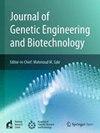Identification of key biomarker genes in liver hepatocellular carcinoma and kidney renal clear cell carcinoma progression: A shared high-throughput screening and molecular docking method with potentials for targeted therapeutic interventions
IF 2.8
Q3 Biochemistry, Genetics and Molecular Biology
Journal of Genetic Engineering and Biotechnology
Pub Date : 2025-04-22
DOI:10.1016/j.jgeb.2025.100497
引用次数: 0
Abstract
Background and objectives
Liver Hepatocellular Carcinoma (LIHC) and Kidney Renal Clear Cell Carcinoma (KIRC) are leading causes of cancer death worldwide, but their early detections remain hindered by a lack of genetic markers. Our study aims to find prospective biomarkers that could serve as prognostic indicators for efficient drug candidates for KIRC and LIHC treatment.
Methods
To detect differentially expressed genes (DEGs), four datasets were used: GSE66271 and GSE213324 for KIRC, and GSE135631 and GSE202853 for LIHC. Visualization of DEGs was done using heatmaps, volcano plots, and Venn diagrams. Hub genes were identified via PPI analysis and the cytoHubba plugin in Cytoscape. Their expression was evaluated using box plots, stage plots, and survival plots for prognostic assessment via GEPIA2. Molecular docking with PyRx’s AutoDock Vina identified optimal binding interactions between compounds and proteins. Pharmacokinetic and toxicity analyses reinforced the drug-likeness and safety of these compounds.
Results
In this study, 47 DEGs were identified, with the top 10 hub genes being TOP2A, BUB1, PTTG1, CCNB2, NUSAP1, KIF20A, BIRC5, RRM2, NDC80 and CDC45, chosen for their high MCC scores. Data mining revealed a correlation between TOP2A expression and clinical survival outcomes in KIRC and LIHC patients. Docking studies of the TOP2A structure identified a promising compound from Andrographis paniculata with high binding energy and interactions with TOP2A. Pharmacokinetic and toxicity assessments support its potential as a drug candidate.
Conclusion
Our study emphasizes TOP2A’s prognostic significance in KIRC and LIHC and recognizes Andrographis paniculata compound as potential therapeutics, offering prospective for enhanced treatment and patient outcomes in these cancers.
肝细胞癌和肾透明细胞癌进展的关键生物标志物基因鉴定:一种具有靶向治疗干预潜力的共享高通量筛选和分子对接方法
背景和目的肝细胞癌(LIHC)和肾透明细胞癌(KIRC)是世界范围内癌症死亡的主要原因,但由于缺乏遗传标记,它们的早期检测仍然受到阻碍。我们的研究旨在寻找可作为KIRC和LIHC治疗有效候选药物的预后指标的前瞻性生物标志物。方法为了检测差异表达基因(DEGs),使用了四个数据集:KIRC的GSE66271和GSE213324, LIHC的GSE135631和GSE202853。使用热图、火山图和维恩图对deg进行可视化。通过PPI分析和cytoHubba插件在Cytoscape中鉴定Hub基因。使用箱形图、分期图和生存图进行评估,通过GEPIA2进行预后评估。与PyRx的AutoDock Vina进行分子对接,确定了化合物与蛋白质之间的最佳结合相互作用。药代动力学和毒性分析加强了这些化合物的药物相似性和安全性。结果共鉴定出47个基因,前10位的枢纽基因为TOP2A、BUB1、PTTG1、CCNB2、NUSAP1、KIF20A、BIRC5、RRM2、NDC80和CDC45,这些基因的MCC评分较高。数据挖掘揭示了TOP2A表达与KIRC和LIHC患者临床生存结果之间的相关性。对TOP2A结构的对接研究发现穿心莲中一种具有高结合能并与TOP2A相互作用的有前景的化合物。药代动力学和毒性评估支持其作为候选药物的潜力。结论本研究强调了TOP2A在KIRC和LIHC中的预后意义,并认可穿心莲化合物作为潜在的治疗药物,为这些癌症的强化治疗和患者预后提供了前景。
本文章由计算机程序翻译,如有差异,请以英文原文为准。
求助全文
约1分钟内获得全文
求助全文
来源期刊

Journal of Genetic Engineering and Biotechnology
Biochemistry, Genetics and Molecular Biology-Biotechnology
CiteScore
5.70
自引率
5.70%
发文量
159
审稿时长
16 weeks
期刊介绍:
Journal of genetic engineering and biotechnology is devoted to rapid publication of full-length research papers that leads to significant contribution in advancing knowledge in genetic engineering and biotechnology and provide novel perspectives in this research area. JGEB includes all major themes related to genetic engineering and recombinant DNA. The area of interest of JGEB includes but not restricted to: •Plant genetics •Animal genetics •Bacterial enzymes •Agricultural Biotechnology, •Biochemistry, •Biophysics, •Bioinformatics, •Environmental Biotechnology, •Industrial Biotechnology, •Microbial biotechnology, •Medical Biotechnology, •Bioenergy, Biosafety, •Biosecurity, •Bioethics, •GMOS, •Genomic, •Proteomic JGEB accepts
 求助内容:
求助内容: 应助结果提醒方式:
应助结果提醒方式:


